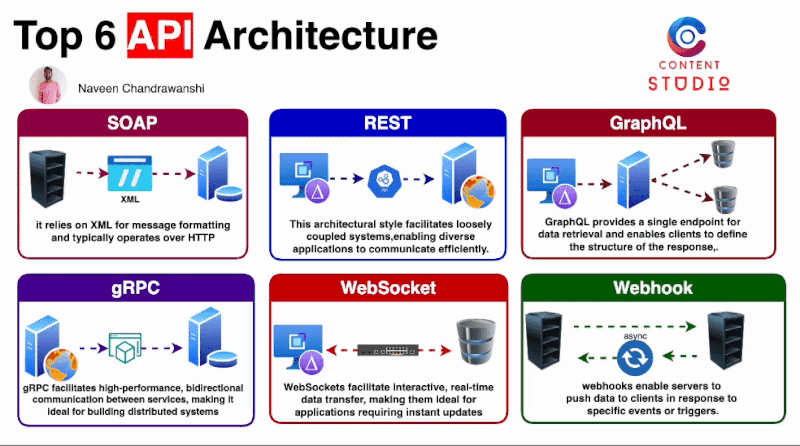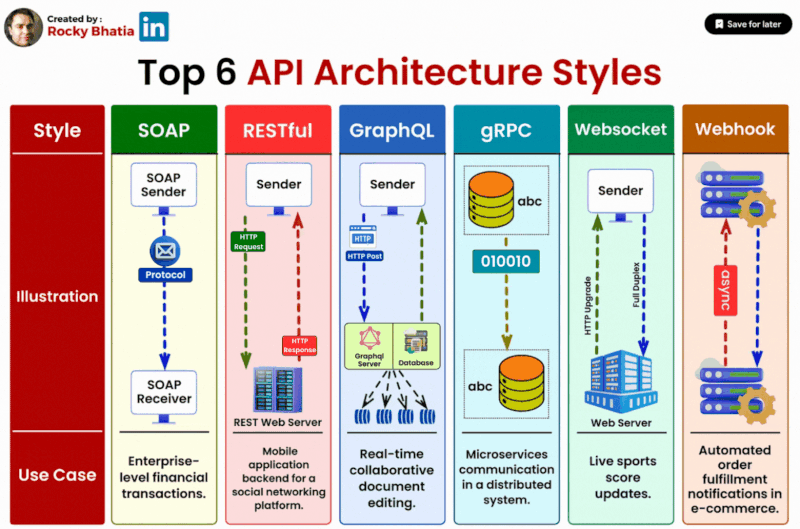
API Architecture refers to the structural design of Application Programming Interfaces (APIs) that defines how they are built, how they function, and how they interact with other software components. It encompasses the principles, practices, and patterns used to create robust, scalable, and efficient APIs that serve as the backbone of modern software applications and services.
At its core, API architecture is about creating a blueprint for how different software components communicate and exchange data. It defines the rules of engagement between client applications and server-side resources, establishing protocols for data formats, request-response cycles, authentication methods, and error handling. A well-designed API architecture ensures that different parts of a system can interact seamlessly, even if they’re built on different technologies or maintained by different teams.
API architecture is not just about technical specifications; it’s also about creating a developer-friendly ecosystem. It involves designing intuitive endpoints, providing clear documentation, and ensuring that the API is easy to use and integrate. Good API architecture considers factors like performance, security, scalability, and maintainability from the ground up.

How API Architecture Helps
- Modularity and Flexibility:
API architecture promotes a modular approach to software development. By breaking down complex systems into smaller, manageable components that communicate via APIs, developers can create more flexible and adaptable systems. This modularity allows for easier updates, replacements, or scaling of individual components without affecting the entire system. - Improved Scalability:
Well-designed API architecture facilitates horizontal scaling. As demand increases, additional instances of API servers can be deployed to handle the load. This is particularly crucial in cloud-based environments where resources need to be dynamically allocated based on traffic patterns. - Enhanced Security:
API architecture incorporates security at its core. It defines how authentication and authorization should be handled, how sensitive data should be encrypted, and how to protect against common vulnerabilities. A robust API architecture includes measures like rate limiting, input validation, and secure token management to safeguard against potential threats. - Faster Development and Integration:
By providing a clear contract between different software components, API architecture accelerates development cycles. Developers can work on different parts of a system simultaneously, knowing how they will interact through well-defined APIs. This also simplifies the integration of third-party services and tools, as developers can rely on documented API specifications. - Improved User Experience:
API architecture influences how quickly and efficiently data can be retrieved and processed. A well-architected API can significantly improve application performance, leading to better user experiences. This is particularly important in mobile applications where network conditions may be variable. - Version Management:
API architecture includes strategies for versioning, allowing developers to introduce new features or make changes without breaking existing integrations. This ensures backward compatibility and provides a smooth transition path for API consumers. - Analytics and Monitoring:
A good API architecture incorporates mechanisms for logging, monitoring, and analytics. This provides valuable insights into API usage patterns, performance metrics, and potential issues, allowing for continuous improvement and optimization. - Cross-platform Compatibility:
By abstracting the underlying implementation details, API architecture enables cross-platform compatibility. The same API can serve web, mobile, and desktop applications, ensuring consistency across different platforms. - Business Agility:
API architecture supports rapid prototyping and experimentation. New features or products can be quickly developed by leveraging existing APIs, allowing businesses to respond swiftly to market demands or competitive pressures. - Ecosystem Development:
For companies looking to build platforms or developer ecosystems, API architecture is crucial. It defines how third-party developers can interact with the platform, fostering innovation and expanding the platform’s capabilities through external contributions.
List of API Architecture Styles
- REST (Representational State Transfer):
REST is one of the most popular API architectures, known for its simplicity and scalability. It uses standard HTTP methods (GET, POST, PUT, DELETE) and is stateless, meaning each request from a client contains all the information needed to understand and process the request. REST APIs typically return data in JSON or XML format and are widely used for web services. Key characteristics:- Stateless communication
- Uniform interface
- Client-server separation
- Cacheable responses
- Layered system architecture
- SOAP (Simple Object Access Protocol):
SOAP is a protocol-based API architecture that uses XML for message formatting and typically relies on HTTP or SMTP for message transmission. It’s known for its strict standards and built-in error handling, making it popular in enterprise environments and for applications requiring high security. Key characteristics:- XML-based messaging
- Platform and language independent
- Works well with distributed enterprise environments
- Built-in error handling
- Supports WS-Security for enterprise-level security
- GraphQL:
GraphQL is a query language for APIs and a runtime for executing those queries. It allows clients to request exactly the data they need, and nothing more, making it highly efficient for applications with complex data requirements or those operating under constrained network conditions. Key characteristics:- Flexible querying with a single endpoint
- Strong typing system
- Hierarchical structure
- Real-time updates with subscriptions
- Introspection for self-documentation
- gRPC (gRPC Remote Procedure Call):
Developed by Google, gRPC is a high-performance, open-source framework that uses Protocol Buffers as its interface definition language. It’s designed for low-latency, highly scalable distributed systems and is particularly well-suited for microservices architectures. Key characteristics:- Uses HTTP/2 for transport
- Supports streaming
- Language agnostic
- Strongly typed contracts
- Efficient serialization
- WebSocket:
WebSocket provides full-duplex, bidirectional communication channels over a single TCP connection. It’s ideal for real-time applications that require constant data exchange between client and server, such as chat applications or live updates. Key characteristics:- Persistent connection
- Real-time, bidirectional communication
- Reduced latency compared to HTTP polling
- Supports text and binary data
- Works well with firewalls and proxies
- Webhooks (Reverse APIs):
Webhooks allow servers to push data to client applications in real-time when certain events occur. Instead of clients constantly polling for updates, the server sends HTTP POST requests to a pre-configured URL when there’s new information. Key characteristics:- Event-driven architecture
- Reduces unnecessary API calls
- Real-time updates
- Asynchronous communication
- Ideal for notifications and data synchronization
- MQTT (Message Queuing Telemetry Transport):
MQTT is a lightweight messaging protocol designed for constrained devices and low-bandwidth, high-latency networks. It’s widely used in Internet of Things (IoT) applications and mobile scenarios where small code footprint and minimal network bandwidth are required. Key characteristics:- Publish/subscribe messaging pattern
- Low overhead and minimal packet size
- Support for unreliable networks
- Three levels of Quality of Service (QoS)
- Last Will and Testament feature for detecting client disconnection
- AMQP (Advanced Message Queuing Protocol):
AMQP is an open standard application layer protocol for message-oriented middleware. It supports reliable communication via message delivery guarantees and is often used in financial services for its robustness and reliability. Key characteristics:- Reliable queuing
- Routing (including point-to-point and publish-and-subscribe)
- Security and reliability
- Interoperability between compliant systems regardless of language or platform
- OData (Open Data Protocol):
OData is an ISO/IEC approved, OASIS standard that defines a set of best practices for building and consuming RESTful APIs. It provides a way to query and update data using standard HTTP methods, making it easy to work with data across a variety of applications, services, and stores. Key characteristics:- Standardized URL query options
- Metadata description of the data model
- Supports CRUD operations
- Allows for batch processing
- Extensible data model
- JSON-RPC and XML-RPC:
These are simple remote procedure call protocols encoded in JSON or XML. They allow for invoking methods on remote systems as if they were local procedures, making them easy to use and implement. Key characteristics:- Simplicity in design
- Language-agnostic
- Support for both synchronous and asynchronous calls
- Lightweight compared to SOAP
Each of these API architecture styles has its own strengths and is suited for different use cases. The choice of architecture depends on factors such as the nature of the application, performance requirements, scalability needs, and the existing technology stack. Many modern systems also employ a hybrid approach, using different architectural styles for different components or services within the same ecosystem.
In conclusion, API architecture is a critical aspect of modern software design that impacts everything from development speed and system performance to security and scalability. By carefully considering the architectural style and implementing best practices, organizations can create APIs that not only meet their current needs but also provide a solid foundation for future growth and innovation.
Answer from Perplexity: pplx.ai/share